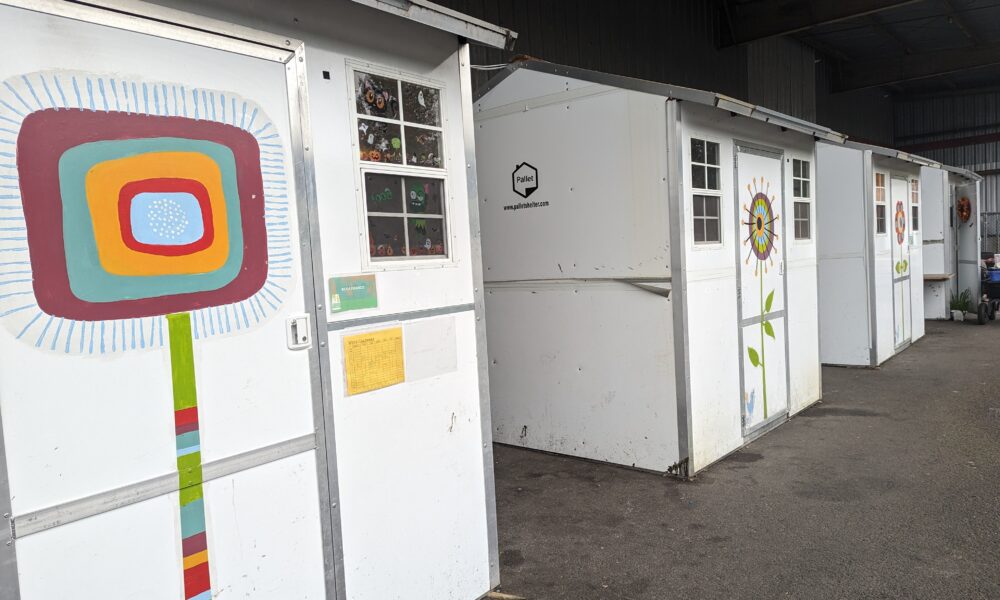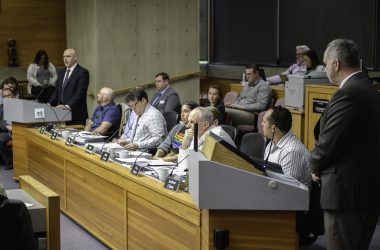Salem needs an organized vision and strategy for addressing homelessness as city government has taken on a greater role in paying for shelters and other services.
That’s according to an outside report commissioned by the city, which also found Salem spent $23.7 million in 2023 responding to homelessness.
The study comes as city leaders consider the intersection of high rates of homelessness and dwindling city budgets. Housing and homeless providers have added hundreds of shelter beds in Salem in recent years thanks to an influx of federal and state money, but making those resources last remains a challenge.
Councilors heard the report’s results during a work session on Tuesday, Feb. 20. Consultant Moss Adams, which conducted the study, and local service providers spoke at the session. Councilors asked them questions about how to apply the report’s findings.
“It wasn’t too long ago that we weren’t doing anything with homelessness,” Mayor Chris Hoy said at the beginning of the meeting. “It’s all just happened in the last few years.”
Of the $23.7 million Salem spent on homelessness last year, over half was for services and programs, like shelters operated by the city or under contract.
The remainder, over $10 million, were “secondary costs” like police, fire and code enforcement calls about homeless people and camps. The fire department accounted for about $7.9 million.
The city last calculated indirect costs for responding to homelessness in 2019, when an internal report pegged the cost at around $5 million.
Homelessness decreased in Salem slightly in 2023 after rising for several years. The annual Point in Time counts, which measure roughly how many people were on Salem streets during a three-day period each January, found that 1,805 people were sleeping in Salem’s shelters or on the streets in 2022. That number decreased by 122 in 2023.
In 2023, Marion County had 936 shelter beds available, ranking eighth best in the state in proportion to the population according to a recent study by Portland State University. Polk County had 16 shelter beds for 256 homeless residents.
“Communities across the region sit at the crux between a desire to assist people experiencing homelessness and impatience and disappointment with the society’s ability to effectively respond to the crisis,” the Salem report said.
Moss Adams consultants began the study in August of 2023 at the request of city leadership. They reviewed homeless services in Salem, took tours and interviewed providers.
The study commended the city’s internal collaboration, its assistance in increasing shelter beds and its work to develop a regional homeless response by giving input to the Mid-Willamette Valley Homeless Alliance, where Mayor Chris Hoy is vice chair. The group brings local governments together to coordinate a regional response to homelessness and sheltering.
But, the city’s response has been piecemeal as funding has come in from the state and federal government. Salem lacks a unified plan that incorporates all available resources, the study said.
“As a result, the City’s response is often reactive and sometimes disconnected between departments,” the report said.
It recommended that the city develop a clear policy direction, continue to promote regional collaboration and bring in more nonprofits.
The city also needs better data management to track consistent goals and metrics across different service providers, and communicate the impact of city-funded services to the public.
Another looming issue is dwindling funds. Of the $13.4 million that the city spent on sheltering and homeless services last year, $11.6 million of that – 87% – came from one-time state and federal money that will run out in the next few years. The rest, $1.8 million, came from the city’s general fund.
That puts new services that were opened with the funding, like micro shelter sites, safe parking and the Navigation Center, at risk of closing if they can’t secure more money from private or government entities.
“We’re just going to have to take a very aggressive posture toward external resources and continue to bring them into the city,” said Jimmy Jones, Mid-Willamette Valley Community Action Agency at the council work session. “I do think it’s possible, with that work, to keep this level of work up long-term. But it’s not going to be easy, and it’s not going to be without sweating a few nights, wondering whether we’re going to be getting the resources or not.”
The city won’t provide additional funding to micro shelter villages operated by Church at the Park which house 232 people, including families, at three sites. Their annual operations cost $4.2 million, and they were opened using one-time grants. They’re at risk of closing this July if no other sources are found.
DJ Vincent, founding pastor of Church at the Park, said Tuesday evening that the Village of Hope site will be considered for funding during this legislative session, and the emergency need has put it on the state’s shortlist.
He said that the family site, located on Northeast Portland Road is moving from city funding to funding from the Homeless Alliance, in a new contract lasting through June 30, 2025.
“That’s great news for our community, and all those families being transitioned out of homelessness,” Vincent said.
The city’s Navigation Center, which opened 75 beds paired with case management last year, is at risk of closing in July 2025 if additional money isn’t secured. It costs about $2.1 million a year to run and is operated under contract with the Mid-Willamette Valley Community Action Agency.
“As the City undergoes a process to address its revenue shortfall, leaders should continue efforts to evaluate benefits against costs and identify solutions for assessed resource gaps, including investing in infrastructure at the local level, cultivating partnerships with regional service providers, forging public-private partnerships, and other opportunities,” the study said.
The study also said the city should develop a set of consistent and pointed performance measures for all its contracted services, which will help it set measurable goals. Currently, each entity has its own performance measures with varying depth. Some count the number of people served, others track improvements in people’s health and well-being and not all measure whether clients stay in housing once they transition out of homelessness.
Though the study focused on services for people who are homeless, it said that continuing to develop affordable housing and streamlining the ability for at-risk people to move in to housing will also be a key part of an effective response. Affordable housing, generally, means that after paying rent families can still afford to comfortably pay their monthly bills.
Providers at the meeting said that high rents can leave people one blown tire or an injury away from homelessness.
“Until we get control of our affordable housing crisis in Oregon, until we can get rents that are affordable for working families in Salem and cities across Oregon, we’re going to continue to see our number of homeless folks grow over the next 10 years,” Jones said.
Contact reporter Abbey McDonald: [email protected] or 503-575-1251.
SUPPORT OUR WORK – We depend on subscribers for resources to report on Salem with care and depth, fairness and accuracy. Subscribe today to get our daily newsletters and more. Click I want to subscribe!
Abbey McDonald joined the Salem Reporter in 2022. She previously worked as the business reporter at The Astorian, where she covered labor issues, health care and social services. A University of Oregon grad, she has also reported for the Malheur Enterprise, The News-Review and Willamette Week.









